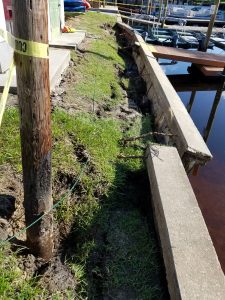Seawalls are an important part of waterfront living, they are vital to keeping the land from meeting the sea and washing away like the sand on a beach. Seawalls or retaining walls are constructed from wood, concrete, steel, vinyl, aluminum, fiberglass, and in a pinch sandbags or any material capable of defending the land from the water.
 Florida soil is sandy and during summer thunderstorms can wash away as water rushes or hurricane seas surge. Erosion isn’t just reserved for storms, as long as the water is moving, erosion is occurring leaving seawalls with cracks, holes and other damage. The best line of defense is a solid seawall. Once damage is noticed, it is vital to get the seawall repaired immediately. Seawall cracks, if left unrepaired will quickly turn into a whole new section of seawall of complete new retaining wall altogether. Damage to the seawall can appear as soil loss on the property, cracking, sinking, or rotation of the seawall or buckling of the seawall.
Florida soil is sandy and during summer thunderstorms can wash away as water rushes or hurricane seas surge. Erosion isn’t just reserved for storms, as long as the water is moving, erosion is occurring leaving seawalls with cracks, holes and other damage. The best line of defense is a solid seawall. Once damage is noticed, it is vital to get the seawall repaired immediately. Seawall cracks, if left unrepaired will quickly turn into a whole new section of seawall of complete new retaining wall altogether. Damage to the seawall can appear as soil loss on the property, cracking, sinking, or rotation of the seawall or buckling of the seawall.
A process called Targeted Grout Injection is used to inject a polyurethane grout into targeted areas allowing for the grout to fill voids and cracks. There is no digging or excavating! The grout reacts with water and soil to form a hard water-tight seal.
Seawall repairs are understood to be wet, and often at or below water levels. When the seawall repair is considerably wet hydrophobic grout is used. Their low viscosity, high expansion rate, and ability to cure under wet conditions makes hydrophobic grout the perfect solutions for these types of seawall repairs. The hydrophobic grout is resilient and can withstand fluctuations in soil content, water movement, retaining its strength and stability.
Seawall repairs can also be made using piles that are driven at specific angles into the ground and attached to the seawalls.
There are several types of new seawall construction available. Curved seawalls resemble waves with a sweeping design that dissipates the impact of the wave. Made from poured concrete, curved seawalls are designed to reduce the removal of sediment “scour” from the seawall.
Gravity seawalls, built in areas where strong soil meets the coastline, rely of heavy materials for stability. Anchored to the soil, these seawalls are prone to shearing and often have extra reinforcement to prevent it.
Steel sheet & pile seawalls are a great solution where the impact of the waves isn’t as great. Anchored to the ground beneath them and the bank behind them, steel sheet & pile seawalls are constructed using interlocking steel sheets.
Concrete block & rock seawalls are generally a low-cost solution using a man-made slope as a foundation. Typically, a mound of rubble is created and heavy boulders are anchored and the water is guided up a gentle slope absorbing the force and making bigger waves into smaller ones.
From building new seawalls to finding the perfect seawall repair erosion solution, Poly Foundation Solutions experts are ready to discuss all types of seawall repair methods.

